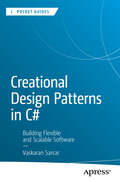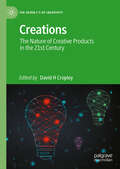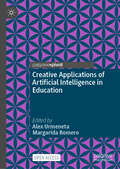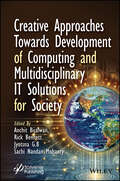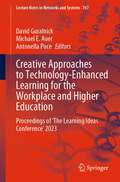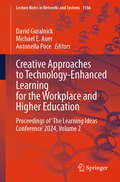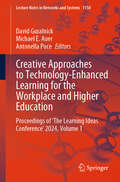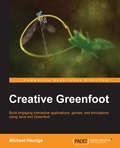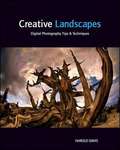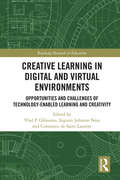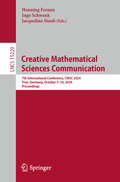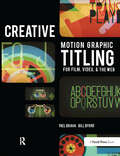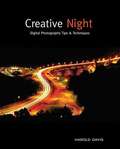- Table View
- List View
Creational Design Patterns in C#: Building Flexible and Scalable Software (Apress Pocket Guides)
by Vaskaran SarcarUnlock the power of design patterns to elevate your software architecture. This pocket book provides an in-depth guide to five essential creational design patterns, crucial for building robust, scalable, and maintainable applications in C#. With step-by-step implementation in C# and a focus on practical applications, this book will empower you to enhance your software solutions and sharpen your design skills. The book starts by covering the simple factory pattern first where you will learn object creation with clear, single-responsibility classes followed by the factory method pattern. Next, you will go through the prototype, singleton, and builder patterns. In the end, you will demonstrate dependency injection with real-life examples. The book breaks down complex concepts into practical examples and concise explanations, making it an invaluable resource at every level of experience. What You Will Learn: Gain insights into the concepts of design patterns. Will be familiar with real-world applications of design patterns Gets a hands-on experience for each of the patterns using the latest version of C#. Some of the alternatives to these patterns with their pros and cons. Who This Book Is For: OOP, C# developers who want to learn and practice design patterns to upgrade their development skills.
Creations: The Nature of Creative Products in the 21st Century (The Seven C’s of Creativity)
by David H CropleyThis edited book explores creative products (i.e. Creations) as part of the seven C's of creativity framework. Through nine chapters, leading scholars in the field explore five different domains (education, crime/terrorism, music, science and engineering) addressing the nature of the creations in each given domain, and the criteria by which creations in that domain are judged. Drawing together key, underpinning concepts from the science of creativity, the book delves into the history of creativity research applied to products to then explore new concepts that are impacting on research, especially the role of artificial intelligence in supporting the development and assessment of creative products.
Creative Applications of Artificial Intelligence in Education (Palgrave Studies in Creativity and Culture)
by Margarida Romero Alex UrmenetaThis open access book explores the synergy between AI and education, highlighting its potential impact on pedagogical practices. It navigates the evolving landscape of AI-powered educational technologies and suggests practical ways to personalise instruction, nurture human-AI co-creativity, and transform the learning experience. Spanning from primary to higher education, this short and engaging volume proposes concrete examples of how educational stakeholders can be empowered in their AI literacy to foster creativity, inspire critical thinking, and promote problem-solving by embracing AI as a tool for expansive learning. Structured in three parts, the book starts developing the creative engagement perspective for learning and teaching to then present practical applications of AI in K-12 and higher education, covering different fields (teacher education, professional education, business education) as well as different types of AI supported tools (games, chatbots, and AI assisted assessment). It also delves into the ethical considerations, policy implications, and the central role educators play in harnessing the power of an AI informed educational experience.
Creative Approaches Towards Development of Computing and Multidisciplinary IT Solutions for Society
by Sachi Nandan Mohanty Anchit Bijalwan Rick Bennett Jyotsna G. BThis book containing 33 chapters provides an insightful look at creative approaches toward the accelerated development of computing and multidisciplinary IT solutions for society. Technology is advancing on all fronts and is opening new and innovative adaptations to our modern world every single day causing huge shifts in practices and patterns. These new technologies allow us opportunities to gain insights into the discoveries of creative and innovative approaches. The book covers emerging next-generation computing research, developments of computing, and multidisciplinary ICT solutions in seven themes: The first theme concerns the emerging research into next-generation computing like cloud computing, cyber security, and gaming; The second theme pertains to information technology in the textile industry; The third theme zeroes in on the adoption of ICT for digitalization, artificial intelligence, and machine learning; The fourth theme addresses online collaboration in the creative process; The fifth theme covers the development of computing and multidisciplinary ICT solutions for salient disciplines like education, governance, commerce, and business communication; The sixth theme provides a security assessment and defense strategies for banking and financial institutions; The seventh theme covers creative approaches towards the implementation of the 4th Industrial Revolution. Audience The book has a wide audience comprising specialists in artificial intelligence, information technology, software engineers, data and cyber security scientists, as well as those in the applied areas such as business, finance, industry and manufacturing. Policymakers and consultants will find this book useful as well.
Creative Approaches to Technology-Enhanced Learning for the Workplace and Higher Education: Proceedings of ‘The Learning Ideas Conference’ 2023 (Lecture Notes in Networks and Systems #767)
by Antonella Poce Michael E. Auer David GuralnickNew technologies provide us with new opportunities to create new learning experiences, leveraging research from a variety of disciplines along with imagination and creativity. The Learning Ideas Conference was created to bring researchers, practitioners, and others together to discuss, innovate, and create.The Learning Ideas Conference 2023 was the 16th annual conference and was held as a hybrid event. The conference took place from June 14–16, 2023., both in New York and online, and included a special track: The ALICE (Adaptive Learning via Interactive, Collaborative and Emotional Approaches) Special Track.Topics covered in this book include among others: online learning methodologies, diversity and inclusion in learning, case studies in university and corporate settings, new technologies in learning (such as virtual reality, augmented reality, holograms, and artificial intelligence), adaptive learning, and project-based learning.The papers included in this book are of interest to researchers in pedagogy and learning theory, university faculty members and administrators, learning and development specialists, user experience designers, and others.
Creative Approaches to Technology-Enhanced Learning for the Workplace and Higher Education: Proceedings of ‘The Learning Ideas Conference’ 2024, Volume 2 (Lecture Notes in Networks and Systems #1166)
by Antonella Poce Michael E. Auer David GuralnickNew technologies provide us with new opportunities to create new learning experiences, leveraging research from a variety of disciplines along with imagination and creativity. The Learning Ideas Conference was created to bring researchers, practitioners, and others together to discuss, innovate, and create. The Learning Ideas Conference 2024 was the 17th annual conference and was held as a hybrid event. The conference took place from June 12th-14th, 2024, both in New York and online, and included the ALICE (Adaptive Learning via Interactive, Collaborative and Emotional Approaches) Special Track, and a Special Session from IGIP, the International Society for Engineering Pedagogy. Topics covered in this book include, among others: uses of artificial intelligence in learning, online learning methodologies, case studies in university and corporate settings, new technologies in learning (such as, along with AI, virtual reality, augmented reality, holograms, and more), adaptive learning, and project-based learning. The papers included in this book may be of interest to researchers in pedagogy and learning theory, university faculty members and administrators, learning and development specialists, user experience designers, and others.
Creative Approaches to Technology-Enhanced Learning for the Workplace and Higher Education: Proceedings of ‘The Learning Ideas Conference’ 2024. Volume 1 (Lecture Notes in Networks and Systems #1150)
by Antonella Poce Michael E. Auer David GuralnickNew technologies provide us with new opportunities to create new learning experiences, leveraging research from a variety of disciplines along with imagination and creativity. The Learning Ideas Conference was created to bring researchers, practitioners, and others together to discuss, innovate, and create. The Learning Ideas Conference 2024 was the 17th annual conference and was held as a hybrid event. The conference took place from June 12th–14th, 2024, both in New York and online, and included the ALICE (Adaptive Learning via Interactive, Collaborative and Emotional Approaches) Special Track, and a Special Session from IGIP, the International Society for Engineering Pedagogy. Topics covered in this book include, among others: uses of artificial intelligence in learning, online learning methodologies, case studies in university and corporate settings, new technologies in learning (such as, along with AI, virtual reality, augmented reality, holograms, and more), adaptive learning, and project-based learning. The papers included in this book may be of interest to researchers in pedagogy and learning theory, university faculty members and administrators, learning and development specialists, user experience designers, and others.
Creative Black and White
by Harold DavisLearn how breaking photographic rules can result in stunning black-and-white photosBlack-and-white photography poses unique challenges; without color to guide the eye, contrast, lighting, and composition take on even more importance. Renowned photographer Harold Davis explains these elements and demonstrates the basic rules of black and white photography as well as when and how to break them. He breaks through the complexity of this photographic medium, explores opportunities for black-and-white imagery, and shows how to capitalize on every one.Richly illustrated with the author's own images, this beautiful guide presents the skills needed for great black-and-white photos while encouraging your confidence and creativity.Goes beyond basics to teach photographers how to conquer the challenges posed by black-and-white photographyAppeals to professionals and serious amateurs who are interested in exploring creative black-and-white imageryPresents photography fundamentals and shows how black and white requires some of the rules to be bentEncourages creative thinking and confidenceLavishly illustrated with Harold Davis's outstanding monochromatic photosWhether you're a professional just venturing into black and white or a serious amateur, Creative Black & White will both educate and inspire you.
Creative Character Design 2e
by Bryan TillmanCreate compelling, original characters using archetypes and design elements such as shadows and line with the tips and techniques found in this image-packed book. Bryan Tillman bridges the gap between the technique of drawing characters and the theory of good character design by using case studies, examples of professional art, and literary and pop culture references to teach you how to develop a character, not just draw one. The book also features Character Model Sheets that will guide you through the creation of new and unique characters. Finally, Bryan will break down established character archetypes to show you why and how the different aspects of good character design work. <P><P>Key Features: <li>Learn what makes a character unique and powerful through tools like character model sheets and case studies from established artists. <li>Develop your ability to use story and archetypes to create compelling new characters. <li>See artwork by professional artists as examples of the techniques shown in the book <li>Bridges the gap between the technique of drawing characters and the theory of good character design in a practical, hands-on way - learn how to use story and archetypes to develop compelling, new characters <li>Based on a standing-room only presentation at Comic-Con 2009 in San Diego.
Creative Character Design for Games and Animation
by Jenny HarderThis book takes you through all the basic steps of character design for games and animation, from brainstorming and references to the development phase and final render. It covers a range of styles such as cartoon, stylized and semi-realistic, and explains how to differentiate between them and use them effectively. Using a step-by-step approach for each stage of the process, this book guides you through the process of creating a new character from scratch. It contains a wealth of design tips and tricks as well as checklists and worksheets for you to use in your own projects. This book covers how to work with briefs, as well as providing advice and practical strategies for working with clients and creating art as a product that can be tailored and sold. This book will be a valuable resource for all junior artists, hobby artists, and art students looking to develop and improve their character development skills for games and animation.
Creative Close-Ups
by Harold DavisThe essential guide for digital macro photographers everywhereThe art of macro photography-photographing small objects or super close-ups of small sections of big objects-yields fascinating results, but shooting at this level brings its own set of challenges. Now you can shoot close-ups with confidence and creative flair with this information-packed guide. Renowned photographer Harold Davis provides pages of field-tested techniques on focus, depth-of-field, exposure-even the appropriate equipment to use for this unique niche of digital photography. The book includes stunning and intriguing examples of his work to illustrate concepts.Walks you through the basics of macro photography, whether you're capturing an insect, a flower, a close-up of the texture of a pine cone, or more Shows you how to overcome the challenges of this type of photography, such as using the appropriate equipment and how to handle focus, depth of field, and exposureTakes you beyond the fundamentals to help you develop your own creative styleInforms and inspires you with the author's own stunning examples of macro photography Join the vast and beautiful world of small photography with this essential guide.
Creative Composition
by Harold DavisTake your best shots with this invaluable guide to composition for DSLR camerasSometimes you get the best results by breaking the rules, but first you have to know what the rules are! In this indispensable photography guide, renowned photographer Harold Davis first walks you through the recommended guidelines for composing great shots with your DSLR camera-and then shows you how to break free, build your own unique style, and compose beautiful images with confidence.Provides practical composition basics as well as the artistic tips and tricks eagerly sought by digital SLR camera lovers, who are growing in number as DSLR camera sales continue to growExplores the fundamental rules of composition-then how to break those rules to take captivating and unique imagesInforms and inspires you with the author's own gorgeous examples of landscapes, portraits, close-ups, and other photos that illustrate his conceptsHelps you jump-start your creativity by showing you new ways to seeGo beyond the basics and create a photography style that's all your own with this must-have guide.
Creative Convergence: The AI Renaissance in Art and Design (Springer Series on Cultural Computing)
by James Hutson Jason Lively Bryan Robertson Peter Cotroneo Martin LangEmbark on a journey that transcends the boundaries of art and technology in the groundbreaking realm of Creative Convergence: The AI Renaissance in Art and Design. This isn't just another book on art and technology- it's a journey that sparks curiosity, fuels innovation, and challenges traditional artistic boundaries. Discover the power of generative Artificial Intelligence (AI) as it melds with human expression, propelling artistry into uncharted territories and redefining traditional notions of both originality and creativity. The text is not just about art or AI; it is about the fusion of both, catalyzing a creative revolution that challenges previous assumptions about human-machine collaboration and how ideation, conceptualization, process and execution are radically rethought. Have you ever wondered how/will AI revolutionize training, education and execution in art and design? Delve into this captivating treatment that contextualizes the disruptions we are experiencing today in the technological innovations and artistic responses and integrations of the past five hundred years. Human creativity has always struggled against technological advance, but ultimately integrated and redefined what "art" is in each era. As such, you will see how AI can be incorporated in various artistic disciplines in this study. Explore real-world case studies that showcase AI's practical impact on 3D design, drawing, digital art, and even web design. The book also addresses the controversial question: Can AI be a co-creator in the creative and artistic process, even assisting in creating an original, signature style? Brace yourself for revelations that will challenge your perceptions of traditional artistry.
Creative DIY Microcontroller Projects with TinyGo and WebAssembly: A practical guide to building embedded applications for low-powered devices, IoT, and home automation
by Tobias TheelExplore embedded programming, and get hands-on with real-world embedded projects relating to IoT, low-powered devices, and other complex systems using TinyGo and WebAssemblyKey FeaturesBuild creative embedded apps with TinyGo using low-powered devices and microcontrollersUnderstand the practicality involved in integrating hardware and sensors while programming them using TinyGoUse TinyGo in modern browsers to display embedded applications' statistics on WebAssembly dashboardsBook DescriptionWhile often considered a fast and compact programming language, Go usually creates large executables that are difficult to run on low-memory or low-powered devices such as microcontrollers or IoT. TinyGo is a new compiler that allows developers to compile their programs for such low-powered devices. As TinyGo supports all the standard features of the Go programming language, you won't have to tweak the code to fit on the microcontroller. This book is a hands-on guide packed full of interesting DIY projects that will show you how to build embedded applications. You will learn how to program sensors and work with microcontrollers such as Arduino UNO and Arduino Nano IoT 33. The chapters that follow will show you how to develop multiple real-world embedded projects using a variety of popular devices such as LEDs, 7-segment displays, and timers. Next, you will progress to build interactive prototypes such as a traffic lights system, touchless hand wash timer, and more. As you advance, you'll create an IoT prototype of a weather alert system and display those alerts on the TinyGo WASM dashboard. Finally, you will build a home automation project that displays stats on the TinyGo WASM dashboard. By the end of this microcontroller book, you will be equipped with the skills you need to build real-world embedded projects using the power of TinyGo.What you will learnDiscover a variety of TinyGo features and capabilities while programming your embedded devicesExplore how to use display devices to present your dataFocus on how to make TinyGo interact with multiple sensors for sensing temperature, humidity, and pressure Program hardware devices such as Arduino Uno and Arduino Nano IoT 33 using TinyGoUnderstand how TinyGo works with GPIO, ADC, I2C, SPI, and MQTT network protocolsBuild your first TinyGo IoT and home automation prototypesIntegrate TinyGo in modern browsers using WebAssemblyWho this book is forIf you are a Go developer who wants to program low-powered devices and hardware such as Arduino UNO and Arduino Nano IoT 33, or if you are a Go developer who wants to extend your knowledge of using Go with WebAssembly while programming Go in the browser, then this book is for you. Go hobbyist programmers who are interested in learning more about TinyGo by working through the DIY projects covered in the book will also find this hands-on guide useful.
Creative Digital Photography: 52 Weekend Projects
by Chris GatcumDo you wish you could take better, more exciting photos? Now you can, with 'Creative Digital Photography: 52 Weekend Projects'. Through this collection of handy weekend projects you will get expert insights and clear step-by-step instructions across the field of photography so you too can learn diverse techniques for taking and processing photos, and discover how to make useful equipment for minimal cost. Whether you're making a simple diffuser for your flash, setting up a time-lapse shoot or simply taking a chance and tossing your camera in the air, you will develop your skills, making your own stunning images and standing out from the crowd. Designed for photographers of all levels with the projects graded in complexity.
Creative Expert for Fortniters: An Unofficial Guide to Battle Royale (Master Combat #5)
by Jason RichGet the most out of Fortnite Battle Royale&’s popular Creative mode with Creative Expert. This all-new, unofficial, illustrated guide series will turn you into a master Fortnite: Battle Royale gamer by uncovering all the best strategies and secrets of this wildly popular game. Whether you play Fortnite: Battle Royale on a PC, Mac, Xbox One, PlayStation 4, or your mobile device, you&’ll find everything you need to stay at the top of your game. Each book is packed with useful insider tips on topics like, staying alive longer, exploring, collecting a powerful arsenal, building, and snagging more victories during each match. When it comes to achieving #1 Victory Royale, the Fortnite Battle Royale: Master Combat Series provides the ultimate competitive edge. Thanks to this illustrated how-to guide, you can create inspired custom builds and design a unique environment for hosting matches of up to 16 players. There are plenty of tools available in Creative mode to make your own island designs from scratch. This book will take you through each one and give you tips for staging incredible combat scenarios and customizing fighting locations so you and your online friends can be challenged in ways you&’ve never experienced before. Have fun being the master of your Fortnite world with Creative Expert.
Creative Flash Photography
by Tilo GockelMake a big impression with small flashes! In this book, Tilo Gockel shows you how to make magic by mastering the use of light. You will learn how to use speedlights to create amazing photographs in any lighting situation. Tilo uses 40 lighting workshops to teach his methods for producing impressive flash shots in portrait, fashion, macro, food, still life, and high-speed photography.The richly illustrated, easy-to-understand workshops are filled with recommendations and instructions for flash setups, detailed lighting diagrams, and tips and tricks for how to achieve the look of high-end studio shots using simple, accessible equipment, even in your own home. Also included is information on the settings that will help you master complex multi-flash situations, as well as tips on how to create cost-effective, self-built accessories.Foreword by Strobist.com's David Hobby.
Creative Greenfoot
by Michael HaungsThis book is for coding students and Java programmers of all levels interested in building engaging, interactive applications with Greenfoot. Familiarity with the very basics of Greenfoot is assumed.
Creative ICT
by Antony Smith Simon WillcocksFirst Published in 2005. Promoting pupils' creativity in using ICT, this book also encourages learning across core and foundation subjects. The text includes: flexible activities for pupils to work through on their own, in small groups or at home; time-saving screen shots for pupils to refer to as they work through the activities; helpful examples of work so that pupils know what to aim for; additional support sheets that can be used by the pupil or the teacher; departure points for integrated studies; and extension activities that will encourage further creativity. For primary and secondary teachers and ICT- co-ordinators.
Creative Landscapes
by Harold DavisCapture the beauty of the world around you with this professional adviceLandscape photography inspires millions of photographers. If you're one of them, you'll find new insight into landscape photography in this book by professional photographer Harold Davis, as well as tips, tricks, and technical advice to help you improve the quality of your photos. You'll learn to use lighting and composition creatively, choose and use appropriate equipment, look at your subject matter in a new way, and even when to break the rules in order to capture the best image of all. Illustrated with the author's own spectacular landscape photos.Landscape photography intrigues and inspires photographers, but there is more to getting great landscape photos than many photographers expectProfessional photographer Harold Davis teaches tricks and techniques that will enhance your skillsExplains how to approach the subject creatively, choose and use appropriate equipment, and refine photographic technique to create spectacular landscape shotsLooks at how lighting, texture, and composition affect landscape imageryLavishly illustrated with the author's own photosLandscapes have long been a popular photographic subject; this book helps you advance your skills as a landscape photographer.
Creative Learning in Digital and Virtual Environments: Opportunities and Challenges of Technology-Enabled Learning and Creativity (Routledge Research in Education)
by Vlad P. Glăveanu; Ingunn Johanne Ness; Constance de Saint LaurentOriginally published as a special issue of the Creativity Research Journal, this volume gives a balanced and reflective account of the challenges and opportunities of technology-enabled creative learning in contemporary societies. Providing a current and updated account of the challenges posed by the Coronavirus to online education, chapters more broadly offer conceptual reflections and empirically informed insights into the impact of technology on individual and collective creativity and learning. These thoughts are explored in relation to school achievement, the development of digital educational resources, online collaboration, and virtual working. Further, the book also considers how the creative use of technology poses risks to learning through the accidental or deliberate dissemination of misinformation, and online manipulation of common societal values in the era of COVID-19. Creative Learning in Digital and Virtual Environments looks at the connection between creativity, learning, and school achievement, and analyses the impact of virtual environments on creative expression. It will appeal to postgraduate students in the fields of creativity and learning, as well as to students and academics involved with broader research in areas such as the role of technology in education, e-Learning and distance education. Vlad P. Glăveanu is Associate Professor and Head of the Department of Psychology and Counselling at Webster University Geneva, Switzerland, as well as Associate Professor II at the University of Bergen, Norway. Ingunn Johanne Ness is a Senior Researcher at the Centre for the Science of Learning & Technology, University of Bergen, Norway. Constance de Saint Laurent is a Postdoctoral Researcher at the University of Bologna, Italy.
Creative Lighting: Digital Photography Tips and Techniques
by Harold DavisHow to make digital photography lighting more creative--and less challenging!How do you master the art of lighting your photographs? Go beyond the basics, go beyond the "rules," and get creative with the help of renowned photographer Harold Davis. In this book, Harold shows you how to break the boundaries of conventional wisdom and create unique, lively, and beautifully lit photographs. Packed with tips and tricks as well as stunning examples of the author's creativity, this book will both inform and inspire you to create your own lighting style.Teaches you when and how to control the light in your photographsReviews the basic "rules" of digital photography lighting and shows you how to break the rules to create your own uniquely lit imagesHelps you start building a lighting style of your ownIncludes stunning examples of the author's photography and lighting techniquesWhether you're a beginner or a seasoned digital photographer, you'll find ideas and techniques to spark your creativity.
Creative Mathematical Sciences Communication: 7th International Conference, CMSC 2024, Trier, Germany, October 7–10, 2024, Proceedings (Lecture Notes in Computer Science #15229)
by Henning Fernau Inge Schwank Jacqueline StaubThis book constitutes the refereed proceedings of the 7th International Conference on Computer Science and Mathematics , CMSC 2024, held in Trier, Germany, during October 7–10, 2024. The 17 full and short papers included in this book were carefully reviewed and selected from 26 submissions. They were organized in topical sections as follows: Invited Papers; Tactile Learning: Unplugged Graphs, Trees, and Patterns; Teaching Advanced Concepts Using Tangible Machines; Curricular Desicion-Making; Computational Thinking and Interdisciplinary Instruction; Innovative Teaching Beyond the Classroom.
Creative Motion Graphic Titling: Titling with Motion Graphics for Film, Video, and the Web
by Bill Byrne Yael BrahaThe book features genre-based tutorial sections, with step by step instructions for creating effective horror, comedy, drama, and suspense titling sequences. Tutorials for creating some of the most popular title sequences in blockbuster movies are included (Se7en, The Sopranos, 24, The Matrix). Other tutorials teach you how to effectively use sound and VFX in your titles, and also included is instruction on editing your title sequence. These techniques, as well as chapters on the essentials of typography allow you to apply these lessons to your title sequence regardless of whether it's for TV, the web, or digital signage. Also included is a DVD with sample clips, as well as project files that allow you to refine the techniques you learned in the book. As an added bonus we've included 3 titling chapters from other Focal books, with specific instructions on titling within certain software applications. Cover images provided by MK12, from The Alphabet Conspiracy. Learn more at www.MK12.com
Creative Night
by Harold DavisTake a well-timed shot in the dark with this invaluable guide to night photographyShooting in low light and at night is challenging, but it can result in stunning images, so don't put that digital camera away after the sun goes down! Start capturing eerie and intriguing photographs at all levels of light with this information-packed guide from renowned photographer and author Harold Davis.He provides pages of field-tested techniques to help you find the proper exposures, including the best settings for ISO, aperture, and shutter. Don't miss the intriguing examples of his own work, including cityscapes, landscapes, and more.Walks readers through the intricacies of night and low light photography Explores the fundamental rules of exposure, including creative settings for ISO, aperture, and shutter speedsInforms and inspires with the author's own breathtaking examples of night photography, including cityscapes, landscapes, exciting night events, and other photos that illustrate the concepts Capture the visually exciting world after the sun goes down with this essential guide to night photography.
